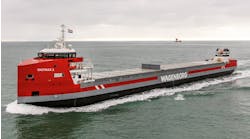Ian Taylor
ALE – Offshore Services
Installing offshore facilities in shallow water presents a unique set of challenges, both physical and commercial. For many years, the offshore industry has turned to high deck mating floatover installation techniques in these conditions as an alternative to heavy-lift construction vessels. But for the Zhao Dong block development offshore China, water depth, tidal patterns, and barge availability required a different approach.
The Zhao Dong block covers 50,000 acres (20,234 ha) in Bohai Bay, 145 mi (233 km) southeast of Beijing. The development’s first two platforms – weighing 6,126 tons (5,557 metric tons) and 5,560 tons (5,044 metric tons), respectively – were installed during 2002-03 using a combination of floatover methods and lifting strand jacks.
Due to the success of this approach, the process was replicated in 2008 to expand the development via the addition of one 3,100-ton (2,812-metric ton) platform and one 1,800-ton (1,633-ton) platform. The final installation was completed this past June.
At low tide, the water depth at the installation site could be as a low as 6 ft (1.8 m), preventing access by most floating cranes, while the tidal variation necessitated an elevated installation height. Because of these constraints, only barges of a limited size were available for towing the structures from the fabrication yard to the offshore site, requiring a low center of gravity of the topsides cargo for stability in transit. A raised transportation frame with a high transit center of gravity was not viable.
The solution was for the platforms to be lifted to their installation elevation once offshore. To accomplish this, ALE – Offshore Services developed a system using high-capacity strand jacks to keep each platform at a low level during sea tow, and then lifting it to its final elevation once on site.
Engineering to integrate the strand jacks into the Zhao Dong topside project began in the design phase for the initial installation in 2002. Because of the shallow water depth, each of the eight-leg topsides had to be designed so that the deck legs could be retracted to sit flush with the underside of the structure during load-out and tow. Once offshore, the legs would extend below the deck to the pre-installed piles in order to lift the topsides clear of the transportation barge.
The design included platforms mounted on each outer leg for the main lifting strand jacks, as well as deck-mounted goalposts with auxiliary strand jacks to lower the legs when positioned over the pre-installed piles offshore. The main lifting strands were secured to strand anchors mounted beneath the topside deck level at strengthened nodes.
Loadout and towing
With all topsides offshore installation equipment prepared at the fabrication yard prior to loadout, four 180-ton (163-metric ton) strand jacks were employed to pull the bogey-mounted topsides on to the semisubmersible bargeZhong Ren 1501, which was involved in all four installations. The strand jacks were controlled using a computer interface that monitored speed, load, and extension throughout the loadout, and which could automatically compensate between units while the operation was in progress.
ALE performed all onshore and offshore marine engineering for the project. This included ballast engineering and loadout management using the vessel’s internal pumps managed by ALE’s external barge ballast monitoring system, which provided live data on the barge, tide, and active tanks during loadout.
Once the topsides were loaded and sea-fastened, the project moved to the offshore installation phase involving the short voyage from the yard to the offshore site. The barge then was winched between the piles on a rising tide and prepared for lifting to final elevation.
Lowering, lifting, leveling
Two GS-J03 jacks with a 45-ton (40.8-metric ton) capacity were used to lower each of the outer legs from transit height onto the installed piles, and 16 main deck lifting strand jacks – four per corner leg – were applied for the 8-m (26.2-ft), synchronized lift to design elevation. Each strand jack was controlled by a central computer which provided feedback on the center of gravity movement, load, and elevation at each lifting point. The lift itself took just over two hours to complete.
While the weight of the structure was held on the strand jacks, shims on the four outer legs were welded. A single 45-ton (41-metric ton) capacity GS-J03 jack was then applied to each of the internal legs for lowering and insertion into the piles. Jacking brackets and a pair of 500-ton (453-metric ton) hydraulic jacks were fitted at each internal leg and used to balance the loads from the outer four legs and to remove the deck camber, distributing the deck weight between all eight legs. They then were shimmed and welded.
On completion of the welding and inspections, the 16 deck-lifting strand jacks were unloaded gradually until the loads were transferred to the permanent structure.
Once the decision was taken to expand operations in the Zhao Dong block, ALE was commissioned to review the installation procedures. The conclusion was to proceed with the same engineering approach and strand jack operation which had proven efficient and cost-effective for the initial two platforms. The same barge was also used, due to the limitations imposed by the conditions.







